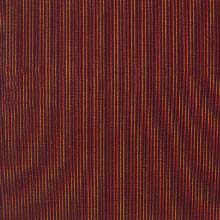Weave (p. 36 )
1. Produced in Akita City, Akita Prefecture.
2. Characteristics: A refined and elegant silk textile. The main designs are vertical stripes and lattice. "Hamanasu"(Rosa rugosa) or "Yama Tsubaki"(Rhodoendron kaempheri, wild azalea) is used as dye. Called also as "Akita Kihachijo". Resembling "Kihachijo" the color grows more clearer when washed more often. Therefore, kimonos made of this cloth reach the finest color three years after it is made. Three different names are given to them according to the dyes used: "Tobi Hachijo", "Akita Kihachijo" and "Kawari Hachijo".
3. Uses: A cloth for kimonos and for "Tanzen"(quilted outer garments).
4. History: The history of this textile in Akita is old. In the Kansei or Kyowa Era(1789-1804 ) textiles were first made by Takiemon Ishikawa, native of the Northeastern District, who produced "Une Ori"(literally, ridge weaving), "Ryumon Ori"(plain textile with thick threads) and "Akita Hira".
In the Bunka Era(1804-1818) the feudal government of Satake invited Jinpei Hishinuma from Kiryu(Gunma Prefecture) to instruct local people the techniques of dyeing and weaving with the aim to develop the industry. He first wove "Hachijo Koshi"(leterally Hachijo Lattice) in imitation of "Kihachijo." It was popular in the late years and was called "Akita Kinu"(Akita Silk). He succeeded in producing specific tobi, brown, color using the roots of "Hamanasu"(Rosa urugosa), which grows wild on the beaches in Akita Prefecture. Because of its graceful color, the Akita Hachijo was popularly sold in Edo(Tokyo), Kyoto and Osaka. In the middle of the Meiji Period 60,000 rolls were produced annually. After the Meiji Period, however, production decreased drastically and today, only one weaving factory is trying to maintain the tradition.
Dyeing Method
The plants used for dyeing are (1) the roots of Hamanasu for brown and reddish brown, (2) "Kariyasu"(Miscanthus tinctorius), "Yama Tsutsuji"(Rhododendron kaempheri, wild azalea) and "Yama momo"(Myrica rubra) for yellow, (3) a blend of "Hamanasu" with another plant dye, and the logwood(Haematoxylon campechianum) for black. Steps for Tobi color dyeing:
(1) Mordant: the reeled threads put through bamboo sticks are compound of iron, aluminum and chrome for 24 hours and then washed in plain water and hydrated.
(2) Pre-dyeing: The threads are dyed for 4-5 minutes in the boiling dye liquid which is obtained by boiling the roots of "Hamanasu" for 7-8 hours.
(3) Dyeing: The threads thus processed are put in a hemp bag. The bag is soaked and stirred in the dye liquid for 4-5 hours. After washing in plain water, the threads are put in lime water to produce the color.



